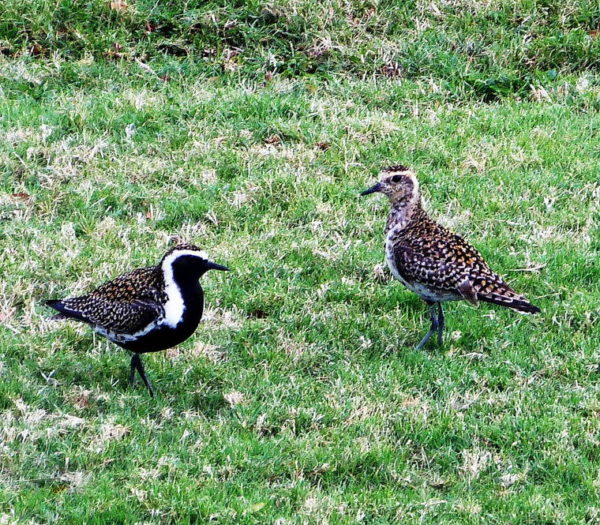Published in the Ocean Watch column, Honolulu Star-Advertiser © Susan Scott
March 21, 2020
While we Hawaii residents are isolating ourselves from members of our own species, we can take the extra time at home to appreciate another species outside our windows. Hawaii’s kolea are in their full spring swing, shedding brown winter feathers and replacing them with the black, white and gold of breeding season.
Replacing most of their feathers in springtime is an enormous energy expenditure for Pacific golden plovers (and other migratory shorebirds), especially since the birds will soon be needing all the fat they can carry to fly to Alaska. But nature has them covered. As the birds dress up for their annual nesting festivities, they’re also bulking up.
 A male, left, and female kolea near Susan Scott’s lanai in April.
A male, left, and female kolea near Susan Scott’s lanai in April.
No one knows whether kolea pair up before they leave for Alaska,
but these two, separate all winter, seemed unusually friendly to one another.
They’re back, but so far, not quite so chummy.
©2020 Susan Scott
When they arrive in Hawaii in late summer and fall, kolea lose weight for a while, weighing their lightest at about 3.7 ounces. This likely occurs because of the energy the birds must exert to stake out, and defend, foraging territories.
Guard duty sometimes involves running up and down an invisible dividing line to warn another bird not to cross. Owning a productive plot of grass is a matter of life or death, and fighting sometimes ensues, turning our delicate-looking kolea into little feathered thugs.
After securing their food source for the winter, kolea get busy eating just about anything that crawls, and their weight stabilizes. Throughout winter the birds average 4 ounces.
Come spring, though, the birds gobble up all the edibles they can get, because in addition to growing those stunning new feathers, the birds also have to store up calories. (If you feed your kolea, please give it only healthy food such as scrambled egg or mealworms.)
When the birds leave Hawaii, they will have almost doubled their weight to 7 ounces. Nearly 40% of the weight gain is fat, fuel for the 3,000-mile nonstop flight.
Showing off vibrant colors is one way the males attract a mate, usually a different one each year (females shop around). Once paired up, though, the fancy outfits go the way of last year’s prom dress. Kolea begin molting their dazzling attire while still sitting on their eggs.
We residents can put our aloha into practice by observing home quarantine, appreciating that we do so surrounded by the beauty of the Hawaiian Islands and in the company of our best-dressed birds. COVID-19 canceled my annual spring trip to Australia, but in that there’s a silver lining. Except it’s not silver. It’s gold.
(A note to all kolea fans: In a project sponsored by the Hawaii Audubon Society, a statewide kolea count will begin soon, managed by plover expert Wally Johnson and me. Via a website, we will ask all plover lovers to report specific kolea locations. Stay tuned for the launch of this fun, interactive site.)